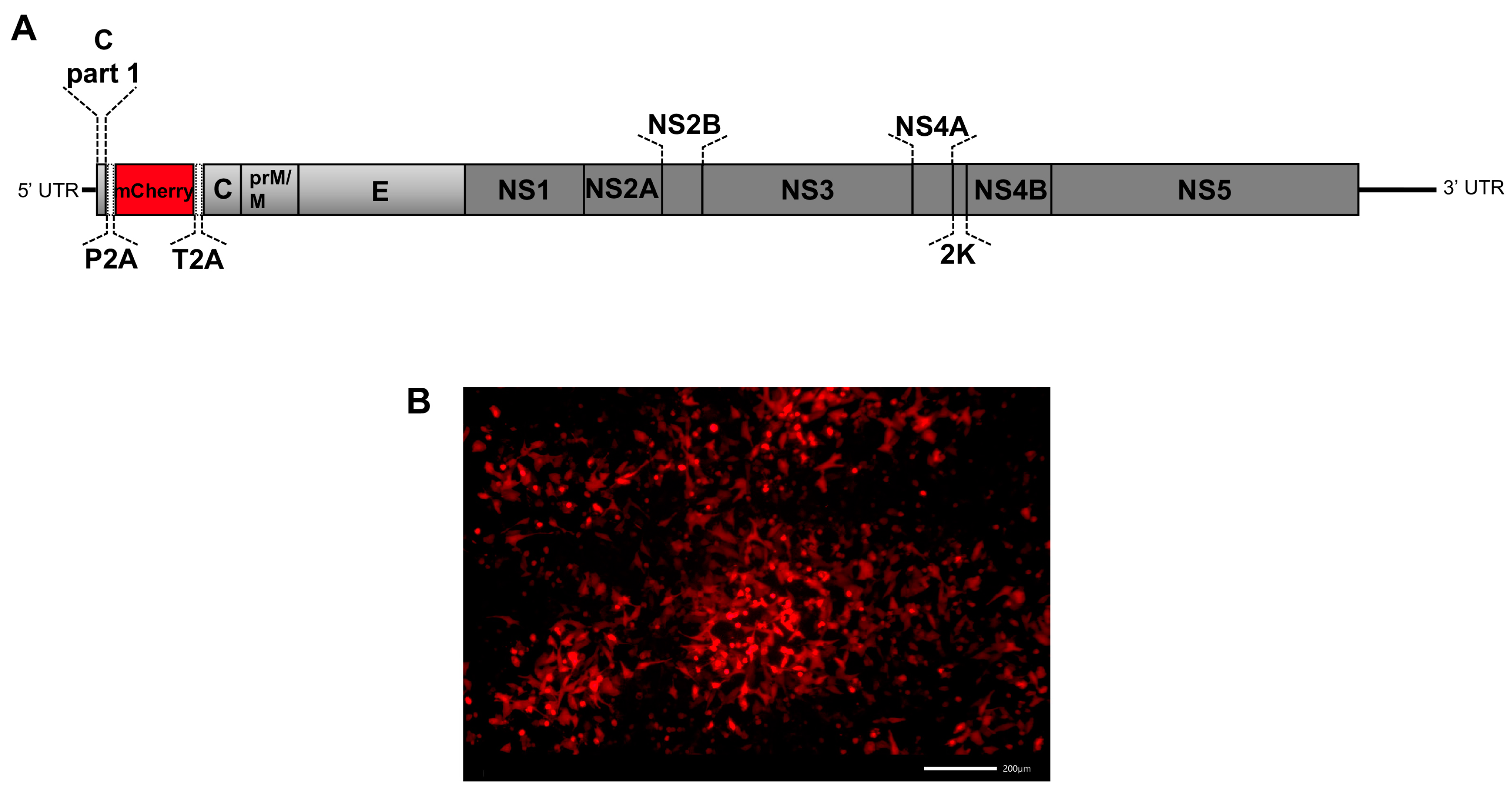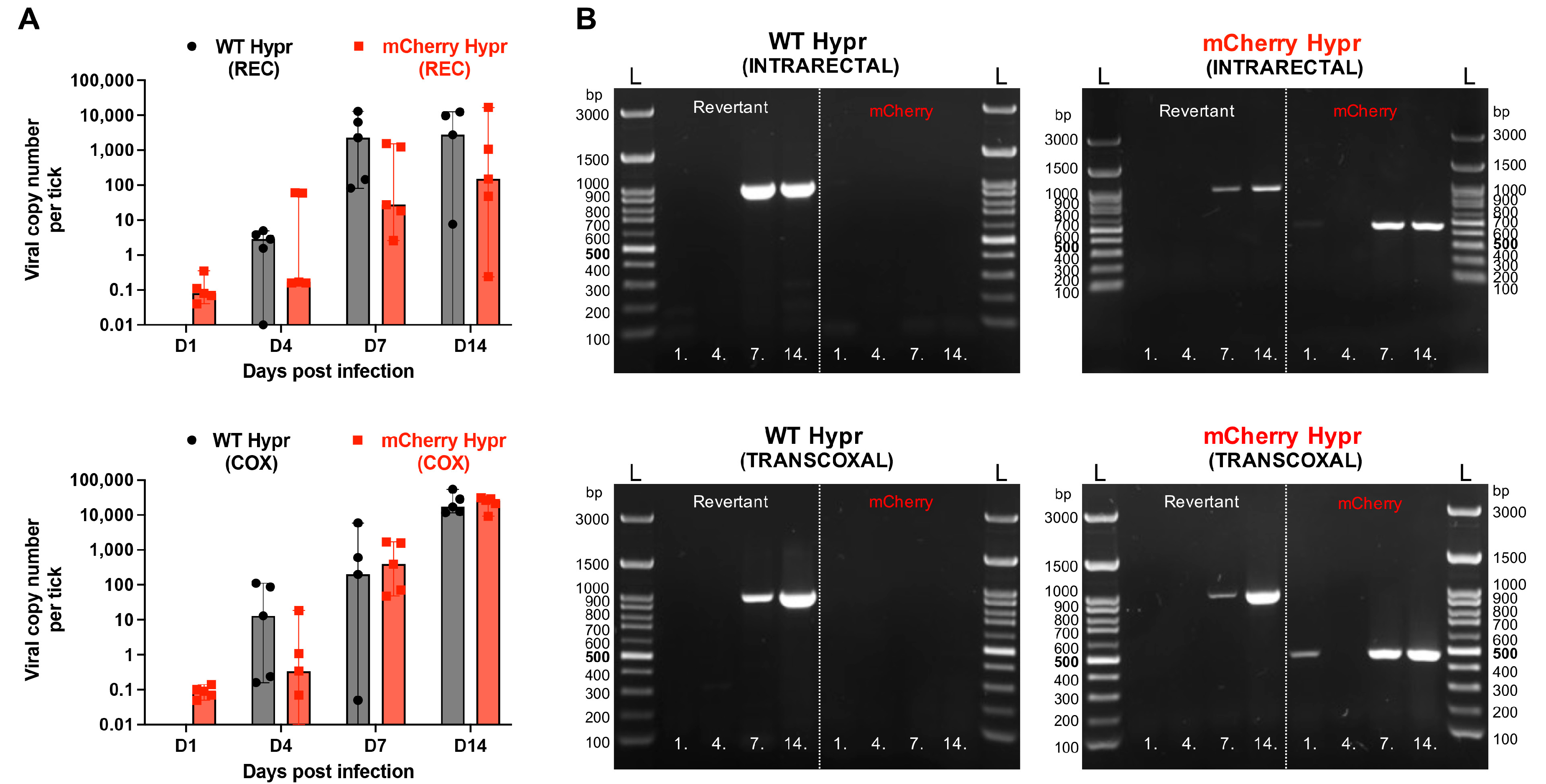Fitness of mCherry Reporter Tick-Borne Encephalitis Virus in Tick Experimental Models
Abstract
1. Introduction
2. Materials and Methods
2.1. Viruses and Cell Lines
2.2. Ticks and Experimental Infection with Viruses
2.3. Viral Plaque Assay
2.4. RNA Isolation, RT-PCR, RT-qPCR, and DNA Sequencing of Capsid Gene
2.5. Propagation of Viruses in Tick Cell Culture
2.6. Live Cell Imaging
2.7. Immunofluorescence Staining
2.8. SDS-PAGE and Western Blotting
3. Results and Discussion
4. Conclusions
Supplementary Materials
Author Contributions
Funding
Institutional Review Board Statement
Informed Consent Statement
Data Availability Statement
Acknowledgments
Conflicts of Interest
References
- Bogovic, P. Tick-borne encephalitis: A review of epidemiology, clinical characteristics, and management. World J. Clin. Cases 2015, 3, 430–441. [Google Scholar] [CrossRef] [PubMed]
- Ruzek, D.; Avšič Županc, T.; Borde, J.; Chrdle, A.; Eyer, L.; Karganova, G.; Kholodilov, I.; Knap, N.; Kozlovskaya, L.; Matveev, A.; et al. Tick-borne encephalitis in Europe and Russia: Review of pathogenesis, clinical features, therapy, and vaccines. Antivir. Res. 2019, 164, 23–51. [Google Scholar] [CrossRef] [PubMed]
- Michelitsch, A.; Wernike, K.; Klaus, C.; Dobler, G.; Beer, M. Exploring the reservoir hosts of tick-borne encephalitis virus. Viruses 2019, 11, 669. [Google Scholar] [CrossRef] [PubMed]
- Lindquist, L.; Vapalahti, O. Tick-borne encephalitis. Lancet 2008, 371, 1861–1871. [Google Scholar] [CrossRef] [PubMed]
- Havlíková, S.; Ličková, M.; Klempa, B. Non-viraemic transmission of tick-borne viruses. Acta Virol. 2013, 57, 123–129. [Google Scholar] [CrossRef]
- Labuda, M.; Danielova, V.; Jones, L.D.; Nuttall, P.A. Amplification of tick-borne encephalitis virus infection during co-feeding of ticks. Med. Vet. Entomol. 1993, 7, 339–342. [Google Scholar] [CrossRef]
- Khasnatinov, M.A.; Tuplin, A.; Gritsun, D.J.; Slovak, M.; Kazimirova, M.; Lickova, M.; Havlikova, S.; Klempa, B.; Labuda, M.; Gould, E.A.; et al. Tick-Borne encephalitis virus structural proteins are the primary viral determinants of non-viraemic transmission between ticks whereas non-structural proteins affect cytotoxicity. PLoS ONE 2016, 11, e0158105. [Google Scholar] [CrossRef]
- Offerdahl, D.K.; Clancy, N.G.; Bloom, M.E. Stability of a tick-borne flavivirus in milk. Front. Bioeng. Biotechnol. 2016, 4, 40. [Google Scholar] [CrossRef]
- Ličková, M.; Havlíková, S.F.; Sláviková, M.; Klempa, B. Alimentary infections by tick-borne encephalitis virus. Viruses 2021, 14, 56. [Google Scholar] [CrossRef]
- Aubry, F.; Nougairède, A.; de Fabritus, L.; Querat, G.; Gould, E.A.; de Lamballerie, X. Single-stranded positive-sense RNA viruses generated in days using infectious subgenomic amplicons. J. Gen. Virol. 2014, 95, 2462–2467. [Google Scholar] [CrossRef]
- De Fabritus, L.; Nougairède, A.; Aubry, F.; Gould, E.A.; de Lamballerie, X. Utilisation of ISA reverse genetics and large-scale random codon re-encoding to produce attenuated strains of tick-borne encephalitis virus within days. PLoS ONE 2016, 11, e0159564. [Google Scholar] [CrossRef] [PubMed]
- Tamura, T.; Igarashi, M.; Enkhbold, B.; Suzuki, T.; Okamatsu, M.; Ono, C.; Mori, H.; Izumi, T.; Sato, A.; Fauzyah, Y.; et al. In vivo dynamics of reporter Flaviviridae viruses. J. Virol. 2019, 93, e01191-19. [Google Scholar] [CrossRef]
- Suphatrakul, A.; Duangchinda, T.; Jupatanakul, N.; Prasittisa, K.; Onnome, S.; Pengon, J.; Siridechadilok, B. Multi-color fluorescent reporter dengue viruses with improved stability for analysis of a multi-virus infection. PLoS ONE 2018, 13, e0194399. [Google Scholar] [CrossRef] [PubMed]
- Yun, S.I.; Song, B.H.; Woolley, M.E.; Frank, J.C.; Julander, J.G.; Lee, Y.M. Development, characterization, and application of two reporter-expressing recombinant zika viruses. Viruses 2020, 12, 572. [Google Scholar] [CrossRef] [PubMed]
- Bell-Sakyi, L.; Zweygarth, E.; Blouin, E.F.; Gould, E.A.; Jongejan, F. Tick cell lines: Tools for tick and tick-borne disease research. Trends Parasitol. 2007, 23, 450–457. [Google Scholar] [CrossRef] [PubMed]
- Salata, C.; Moutailler, S.; Attoui, H.; Zweygarth, E.; Decker, L.; Bell-Sakyi, L. How relevant are in vitro culture models for study of tick-pathogen interactions? Pathog. Glob. Health 2021, 115, 437–455. [Google Scholar] [CrossRef] [PubMed]
- Grabowski, J.M.; Tsetsarkin, K.A.; Long, D.; Scott, D.P.; Rosenke, R.; Schwan, T.G.; Mlera, L.; Offerdahl, D.K.; Pletnev, A.G.; Bloom, E. Flavivirus infection of Ixodes scapularis (black-legged tick) ex vivo organotypic cultures and applications for disease control. mBio 2017, 8, e01255-17. [Google Scholar] [CrossRef] [PubMed]
- Grabowski, J.M.; Nilsson, O.R.; Fischer, E.R.; Long, D.; Offerdahl, D.K.; Park, Y.; Scott, D.P.; Bloom, M.E. Dissecting flavivirus biology in salivary gland cultures from fed and unfed Ixodes scapularis (black-legged tick). mBio 2019, 10, e02628-18. [Google Scholar] [CrossRef]
- Kendall, B.L.; Grabowski, J.M.; Rosenke, R.; Pulliam, M.; Long, D.R.; Scott, D.P.; Offerdahl, D.K.; Bloom, M.E. Characterization of flavivirus infection in salivary gland cultures from male Ixodes scapularis ticks. PLoS Negl. Trop. Dis. 2020, 14, e0008683. [Google Scholar] [CrossRef]
- Driouich, J.S.; Ali, S.M.; Amroun, A.; Aubry, F.; de Lamballerie, X.; Nougairède, A. SuPReMe: A rapid reverse genetics method to generate clonal populations of recombinant RNA viruses article. Emerg. Microbes Infect. 2018, 7, 1–11. [Google Scholar] [CrossRef]
- Atieh, T.; el Ayoubi, M.D.; Aubry, F.; Priet, S.; de Lamballerie, X.; Nougairède, A. Haiku: New paradigm for the reverse genetics of emerging RNA viruses. PLoS ONE 2018, 13, e0193069. [Google Scholar] [CrossRef] [PubMed]
- Haviernik, J.; Eyer, L.; Yoshii, K.; Kobayashi, S.; Cerny, J.; Nougairède, A.; Driouich, J.S.; Volf, J.; Palus, M.; de Lamballerie, X.; et al. Development and characterization of recombinant tick-borne encephalitis virus expressing mcherry reporter protein: A New tool for high-throughput screening of antiviral compounds, and neutralizing antibody assays. Antivir. Res. 2021, 185, 104968. [Google Scholar] [CrossRef] [PubMed]
- Simser, J.A.; Palmer, A.T.; Fingerle, V.; Wilske, B.; Kurtti, T.J.; Munderloh, U.G. Rickettsia Monacensis Sp. Nov., a spotted fever group Rickettsia, from ticks (Ixodes ricinus) collected in a European city park. Appl. Environ. Microbiol. 2002, 68, 4559–4566. [Google Scholar] [CrossRef] [PubMed]
- Munderloh, U.G.; Liu, Y.; Wang, M.; Chen, C.; Kurtti, T.J. Establishment, maintenance and description of cell lines from the tick Ixodes scapularis. J. Parasitol. 1994, 80, 533. [Google Scholar] [CrossRef] [PubMed]
- Bell-Sakyi, L.; Růžek, D.; Gould, E.A. Cell lines from the soft tick Ornithodoros moubata. Exp. Appl. Acarol. 2009, 49, 209–219. [Google Scholar] [CrossRef] [PubMed]
- Slovák, M.; Kazimírová, M.; Siebenstichová, M.; Ustaníková, K.; Klempa, B.; Gritsun, T.; Gould, E.A.; Nuttall, P.A. Survival dynamics of tick-borne encephalitis virus in Ixodes ricinus ticks. Ticks Tick Borne Dis. 2014, 5, 962–969. [Google Scholar] [CrossRef]
- Sirmarova, J.; Salat, J.; Palus, M.; Hönig, V.; Langhansova, H.; Holbrook, M.R.; Ruzek, D. Kyasanur forest disease virus infection activates human vascular endothelial cells and monocyte-derived dendritic cells. Emerg. Microbes Infect. 2018, 7, 1–12. [Google Scholar] [CrossRef]
- Ličková, M.; Fumačová Havlíková, S.; Sláviková, M.; Slovák, M.; Drexler, J.F.; Klempa, B. Dermacentor reticulatus is a vector of tick-borne encephalitis virus. Ticks Tick Borne Dis. 2020, 11, 101414. [Google Scholar] [CrossRef]
- Arias-Arias, J.L.; Mora-Rodríguez, R. Fluorescence imaging approaches in flavivirus research. In Human Viruses: Diseases, Treatments and Vaccines; Springer: Berlin/Heidelberg, Germany, 2021. [Google Scholar]
- Rehacek, J. Arthropod cell cultures in studies of tick-borne togaviruses and orbiviruses in Central Europe. In Arboviruses in Arthropod Cells In Vitro; Yunker, C., Ed.; CRC Press: Boca Raton, FL, USA, 1987; Volume 1, ISBN 0849345057. [Google Scholar]
- Růžek, D.; Bell-Sakyi, L.; Kopecký, J.; Grubhoffer, L. Growth of tick-borne encephalitis virus (European subtype) in cell lines from vector and non-vector ticks. Virus Res. 2008, 137, 142–146. [Google Scholar] [CrossRef]
- Belova, O.A.; Litov, A.G.; Kholodilov, I.S.; Kozlovskaya, L.I.; Bell-Sakyi, L.; Romanova, L.I.; Karganova, G.G. Properties of the tick-borne encephalitis virus population during persistent infection of ixodid ticks and tick cell lines. Ticks Tick Borne Dis. 2017, 8, 895–906. [Google Scholar] [CrossRef]
- Zou, G.; Xu, H.Y.; Qing, M.; Wang, Q.Y.; Shi, P.Y. Development and characterization of a stable luciferase dengue virus for high-throughput screening. Antivir. Res. 2011, 91, 11–19. [Google Scholar] [CrossRef] [PubMed]
- Zhang, Z.R.; Zhang, H.Q.; Li, X.D.; Deng, C.L.; Wang, Z.; Li, J.Q.; Li, N.; Zhang, Q.Y.; Zhang, H.L.; Zhang, B.; et al. Generation and characterization of japanese encephalitis virus expressing GFP reporter gene for high throughput drug screening. Antivir. Res. 2020, 182, 104884. [Google Scholar] [CrossRef] [PubMed]
- Costantini, L.M.; Baloban, M.; Markwardt, M.L.; Rizzo, M.; Guo, F.; Verkhusha, V.V.; Snapp, E.L. A palette of fluorescent proteins optimized for diverse cellular environments. Nat. Commun. 2015, 6, 7670. [Google Scholar] [CrossRef] [PubMed]
- Katayama, H.; Yamamoto, A.; Mizushima, N.; Yoshimori, T.; Miyawaki, A. GFP-like proteins stably accumulate in lysosomes. Cell Struct. Funct. 2008, 33, 1–12. [Google Scholar] [CrossRef] [PubMed]
- Bílý, T.; Palus, M.; Eyer, L.; Elsterová, J.; Vancová, M.; Růžek, D. Electron tomography analysis of tick-borne encephalitis virus infection in human neurons. Sci. Rep. 2015, 5, 10745. [Google Scholar] [CrossRef]
- Torres, F.J.; Parry, R.; Hugo, L.E.; Slonchak, A.; Newton, N.D.; Vet, L.J.; Modhiran, N.; Pullinger, B.; Wang, X.; Potter, J.; et al. Reporter flaviviruses as tools to demonstrate homologous and heterologous superinfection exclusion. Viruses 2022, 14, 1501. [Google Scholar] [CrossRef]





Publisher’s Note: MDPI stays neutral with regard to jurisdictional claims in published maps and institutional affiliations. |
© 2022 by the authors. Licensee MDPI, Basel, Switzerland. This article is an open access article distributed under the terms and conditions of the Creative Commons Attribution (CC BY) license (https://creativecommons.org/licenses/by/4.0/).
Share and Cite
Kevély, Á.; Prančlová, V.; Sláviková, M.; Haviernik, J.; Hönig, V.; Nováková, E.; Palus, M.; Růžek, D.; Klempa, B.; Koči, J. Fitness of mCherry Reporter Tick-Borne Encephalitis Virus in Tick Experimental Models. Viruses 2022, 14, 2673. https://doi.org/10.3390/v14122673
Kevély Á, Prančlová V, Sláviková M, Haviernik J, Hönig V, Nováková E, Palus M, Růžek D, Klempa B, Koči J. Fitness of mCherry Reporter Tick-Borne Encephalitis Virus in Tick Experimental Models. Viruses. 2022; 14(12):2673. https://doi.org/10.3390/v14122673
Chicago/Turabian StyleKevély, Ádám, Veronika Prančlová, Monika Sláviková, Jan Haviernik, Václav Hönig, Eva Nováková, Martin Palus, Daniel Růžek, Boris Klempa, and Juraj Koči. 2022. "Fitness of mCherry Reporter Tick-Borne Encephalitis Virus in Tick Experimental Models" Viruses 14, no. 12: 2673. https://doi.org/10.3390/v14122673
APA StyleKevély, Á., Prančlová, V., Sláviková, M., Haviernik, J., Hönig, V., Nováková, E., Palus, M., Růžek, D., Klempa, B., & Koči, J. (2022). Fitness of mCherry Reporter Tick-Borne Encephalitis Virus in Tick Experimental Models. Viruses, 14(12), 2673. https://doi.org/10.3390/v14122673





